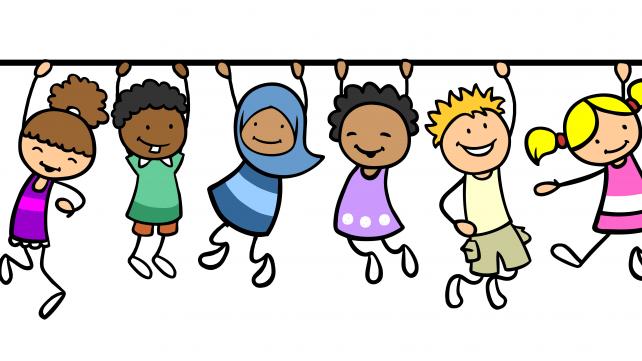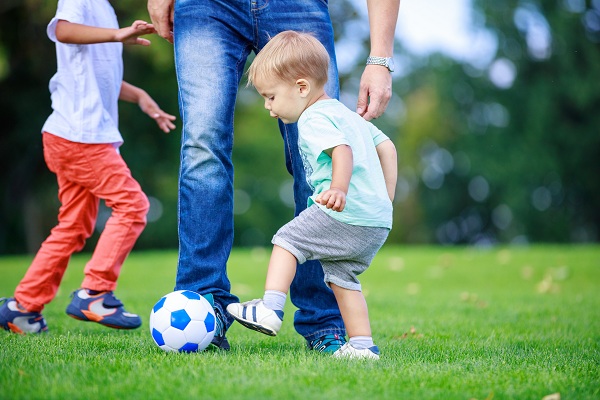
Children love to move.
As soon as they’re aware of their bodies, children are actively trying to move them. They want to roll over and make funny faces. They want to pull hair and pinch other people’s noses. They want to kick and crawl until eventually they learn to walk, run, talk, jump, and climb.
When they’re babies and toddlers, we fuel them with tools and toys that encourage their movement while we clap and cheer them along, taking note of their new abilities in our mental milestone charts. Then later on, as those same active babies and toddlers turn into school-age children, we give them new rules to follow: Don’t run. Don’t jump. Don’t touch. Don’t Make Noise. Sit Still.
The children didn’t change. Their need for movement didn’t change. But our expectations did.
Children Restricted
As our children get older we tend to prioritize social expectations over their physical and developmental needs in preparation for them to enter school, where a large portion of their day will be strictly scheduled and managed.
In the United States, school-aged children as young as five years old can spend up to 6.5 hours per day, five days a week, in school. During that time, most of their day is spent engaging in sedentary, structured activities. In comparison, only 20-30 minutes is dedicated to unstructured, active physical movement and outdoor play during recess (that is, if you live in a state that mandates recess to begin with).
If that child’s school happens to be in a region with less than ideal seasonal weather, recess times are cut or removed all together, and replaced with in-class, structured, often sedentary, alternatives.
This means that for most of their day, for most of their youth, school children’s movements are restricted. Factor in after-school programs, homework, commuting, screen time, weekend schooling, and the ongoing pandemic, and our children are spending even more hours each week moving from one sit-down activity to another.
Yet, the American Academy of Pediatrics (AAP) emphasizes that sedentary behavior is a huge risk factor for disease and long-term health problems. In fact, it’s the times of childhood and adolescence that are “critical periods for developing movement skills, learning healthy habits, and establishing a firm foundation for lifelong health and well-being,” (AAP Physical Activity Guidelines for Americans).
Benefits of Movement for Children and Youth
Regular, active movement has a host of physical benefits for children, including:
- Higher cardiorespiratory fitness
- Stronger muscles and bones
- Lower body fat percentages
But did you know that regular physical movement can also benefit your child’s brain?
Ongoing research in the field of neuroscience shows that physical movement is vital for brain development and learning. Not only does it stimulate and strengthen the brain, but it also helps regulate many of the hormones that contribute to emotional well-being.
Active movement requires the brain to coordinate many things at once, stimulating the growth of new neurons which in turn allows the brain to be able to handle more complex tasks in many different areas, including language, literacy, and math skills.
According to the Center for Disease Control and Prevention’s Keep Recess in Schools initiative, active students make better learners and allowing consistent unstructured movement time during recess is linked with better social emotional outcomes as well academic achievements.
School-aged children who engage in regular physical activity have been shown to have:
- Reduced symptoms of depression
- Reduced symptoms of stress and anxiety
- Increased memory functions
- Increased cognition
- Increased executive functions
- Improved information processing
- Better attention and academic performance
Based on these and other findings, organizations like the AAP, the CDC, and the World Health Organization (WHO) advocate that school-aged children between the ages of 6 and 17 get a minimum of 60 minutes/ 1 hour of moderate to vigorous physical activity every day.
If your child is in the three to five age range, that number goes up to three hours every day, minimum.
But not all movement is created equal and it’s important to consider the age and stage of your children when providing opportunities for movement.

Facilitating Movement for Little Kids
Structured movement is a physical activity that is planned and directed (usually by an adult) to achieve a specific outcome. Think: a game of Simon Says or Dodgeball.
Unstructured movements are physical activities that are initiated and executed by the child for their own motives. Think: free play at the playground or building a blanket fort in the living room.
For young children, toddlers to age 5, the majority of their movement time should be spent in free, unstructured play. Free play is powerful for young children and helps to build strong foundations for learning. Vital skills such as problem solving, collaboration, creativity, and executive functions are all built through unstructured movement and play.
Ideas to encourage children to partake more in unstructured play include:
- Reducing access to screens and devices
- De-scheduling to have more down-time as a family
- Daily time spent outside exploring nature
- Providing ample open-ended tools that help promote self-directed, imaginary play
- Letting your child lead when playing together
- Having books in the home that emphasize free play, curiosity, and imagination
- Providing age-appropriate tools that encourage gross motor development like bikes, scooters, balls, etc
Structured play is also important and can be used with young ones to help:
- Teach developmental skills (like throwing, catching, sorting, and lacing)
- Teach basic educational concepts (like the alphabet or number sense)
- Impart family values through games, stories, or songs
Facilitating Movement for Older Kids
School-aged children can also benefit from time for free play as it allows for opportunities to make their own choices, take reasonable risks, create their own rules, and grow in their independence and social skills.
But older children also benefit from more vigorous structured movements such as sports, whether in teams or individual, group games, and other exercise routines that help them build strength and coordination.
Ideas to encourage older children to get moving:
- Reduce access to screen time and devices OR make their screen time contingent upon daily physical activity being accomplished first
- Try to get physical activity in before and after school
- Try walking or biking to and from school instead of driving
- Sign up for school or community sports
- Get active as a family with daily walks, runs or bike rides
- Hold kids vs. parents ball games at the park
- Work out together as a family
- Start a hiking routine
Encouraging and facilitating movement for our children doesn’t stop when they are babies and toddlers. Continued and consistent opportunities for movement are important for them as they grow in all of their ages and stages, for their bodies as well as their minds.
Recommended Reading:
- How Movement and Exercise Help Kids Learn by Deborah Farmer Kris, May 21, 2019
- Healthy Brain, Happy Life: A Personal Program to Activate your Brain and Do Everything Better by Dr. Wendy Suzuki
- Why Young Kids Learn Through Movement by Lara N. Dotson-Renta, May 19, 2016
- Why Kids Need to Move, Touch and Experience to Learn by Katrina Schwartz, May 26, 2015
- Keep Recess in Schools CDC Publication
- The Power of Play: A Pediatric Role in Enhancing Development in Young Children, American Academy of Pediatrics Clinical Report, September 1, 2018
Melissa Barreto is a home educating mother of five and Co-Founder of Wildflower Homeschool Collective, a homeschool organization based in Northern New Jersey.



Add new comment